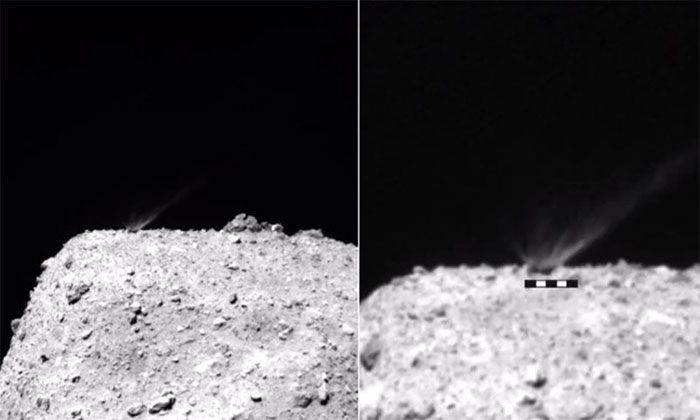Result of a 4.6 billion-year-old asteroid shot of Japanese ship
The Hayabusa 2 spacecraft explodes the surface of Ryugu, creating a sinkhole to help scientists understand the asteroid's composition.
Scientists report the results of an artificial pit on the surface of Ryugu, a carbon rich asteroid about 850 meters wide in the solar system. The research was published in the journal Science on March 19.

The rock splashed as the Hayabusa 2 ship fired asteroid Ryugu.(Photo: Space).
Carbon-rich asteroids make up about three-quarters of known asteroids. They exist from the early days of the solar system, containing primitive materials from the nebula that gave birth to the Sun and planets in the system. Therefore, their study plays an important role to help scientists understand more about the formation process of planets.
In 2014, the Japan Aerospace Exploration Agency (JAXA) launched Hayabusa 2 into space. In 2018, the ship entered Ryugu's orbit and dropped the research robots. As a result, scientists discovered Ryugu could be a porous, porous, 50% hollow rock.
In 2019, Hayabusa 2 fired a device called Small Carry-on Impactor (SCI) at a speed of about 7,200 km / h onto the Ryugu surface. SCI is like a brass bullet weighing about 2 kg, a bit bigger than the tennis ball. The shoot splattered rocks, simultaneously creating a hollow that exposed pristine matter under the surface rock.
The size and number of depressions on asteroids like Ryugu can help scientists estimate their age and surface structure. This estimate is based on models of sinkholes. Data from such artificial collisions on Ryugu could help test the model.
SCI creates a basin of about 14.5 m wide with a raised wall, a conical hole in the center of about 3 m wide and 0.6 m deep . "I was surprised to see such a large pit," said Masahiko Arakawa, lead author of the study, planetary scientist at Kobe University. The crater is 7 times larger than the expected result when performing the same impact on Earth.
The artificial semicircle is semicircular, the material layer is not symmetrical. This shows that there is a large rock in the ground, near the pit.
The characteristics of artificial pits and rock fragments indicate that the size of the pits is limited largely by gravity, not by the solidity of the asteroid surface. This means that Ryugu has a relatively weak surface texture, just like loose sand, consistent with previous studies.
The new finding also shows the Ryugu surface is about 8.9 million years old, while some previous models suggest the age could reach 158 million years. Ryugu is made of 4.6 billion-year-old materials, but it may have been made up of rocky soil from other asteroids only about 10 million years ago.
- New findings on the asteroid Ryugu near the Earth
- Japanese probe brings precious specimens back to Earth
- Japanese explorer ship collects rock samples from Ryugu asteroid
- The Japanese space exploration ship has made great strides in its mission to find the source of life
- The second time Japanese probes kicked down asteroids, sending precious film footage
- NEOWISE detects new asteroids
- Japanese spacecraft cannot land on asteroids
- The mission to bring 4.5-year asteroid specimens back to Earth
- Video: Terrifying scene when stuck in a sinking ship
- Terrible traces of asteroids falling to Laos
- The amount of PC usage reached 1 billion by the end of next year
- Stunned to discover the secret Itokawa asteroid
- The biggest asteroid in the year is rushing towards Earth
- Asteroid hunter wakes up
 Van Allen's belt and evidence that the Apollo 11 mission to the Moon was myth
Van Allen's belt and evidence that the Apollo 11 mission to the Moon was myth The levels of civilization in the universe (Kardashev scale)
The levels of civilization in the universe (Kardashev scale) Today Mars, the sun and the Earth are aligned
Today Mars, the sun and the Earth are aligned The Amazon owner announced a secret plan to build a space base for thousands of people
The Amazon owner announced a secret plan to build a space base for thousands of people Japanese ship brought back to Earth 'dark matter' containing the germ of life?
Japanese ship brought back to Earth 'dark matter' containing the germ of life?  Asteroids near the Earth have a porous structure
Asteroids near the Earth have a porous structure  Japanese probe brings precious specimens back to Earth
Japanese probe brings precious specimens back to Earth  Japan is about to drop the last robot on the asteroid
Japan is about to drop the last robot on the asteroid  New discoveries about Ryugu asteroid near Earth
New discoveries about Ryugu asteroid near Earth  Japanese robots first landed on asteroids
Japanese robots first landed on asteroids 